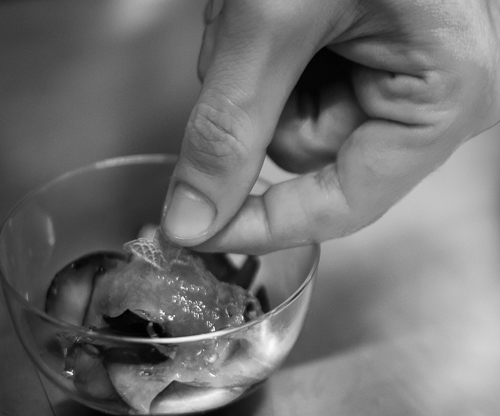Having arrived at the del Carmine olive farm, we first noticed the house with the olive press and numerous olive trees. In fact, we had to ask for directions in order to find out where the olive harvest was taking place. Then, having walked a few hundred metres, we could follow the sound in order to find the workers doing the olive harvest.
The labourers are using a machine which applies a net around the base of the olive tree. The machine makes the tree shake, while the labourers are hitting the branches with big sticks. The harvest is finished after a few minutes, the net is removed from the tree and is closed forming a temporary container for the olives. Then, the closed net is raised above a container into which the olives are let fall by opening the net. When the container is full, it gets transported to the olive oil mill where the contents is emptied into two big aereated plastic cases in order to impede fermentation of the olives.
Production of olive oil
Since the olive harvest is highly mechanized, the olives are harvested together with leaves and parts of the twigs. Naturally, the last ones have to be removed. First, the harvest is poured into a container with a hole at its base. Then, the hole is opened and everything falls down on a conveyor belt where it’s transported to a machine which blows away the twigs and the leaves, while leaving the olives intact. Then, the olives are compressed and transformed into a paste. The paste is then transferred to big containers where it is stirred and made more solid. Then, the paste is led to a centrifuge which separates water and oil from the paste. In addition, the centrifuge will deposit a residue which is used as fertilizer for the trees. That is, the olive trees will receive the nutrients contained in the olives.
The rest of the paste ends up as olive oil and constitutes maximum 20% of the original mass of the olives.
The oils and their characteristics
This farm produces the following 5 types of olive oil:
- the monovariety of Leccino
- the monovariety of Frantoio
- the monovariety of Ascolo (origin: Ascoli Piceno)
the variety FS17 (created by means of liberal pollination of Frantoio at the Institute of Olivoculture in Perugia) - a blend
The wanted characteristics of olive oil include:
- fruity
- piquant
- bitter
The unwanted characteristics of olive oil include:
- rancidness caused by contact with oxygen.
- avvinato (no translation yet) caused by excessive fermentation.
- riscaldo (no translation yet) caused by an advanced degree of lactic fermentation.
The qualities of olive oil are:
- extra virgin
- virgin
- lampante (not for human consumption)
Treatment of the olive trees
The pruning of the olive trees consists of removing some of the branches of the tree in order to force the nutrients to reach the new olives.
Olive oil tasting
Before tasting of olive oil, the oil has to be heated to about 28°C in order to make it emit all its aroma.
Other information
The extension of the farm is 20 hectares where 1 hectare is being used for solar panels.
Other products
The company is also selling chocolate and a cake called panettone, products which are made by local producers using extra virgin oil from del Carmine instead of vegetable fats or butter.
The olive oil is also used for beauty products like face creams and soaps for showering.
The restaurant
There is also a small restaurant located next to the house with the olive press. Paying a modest sum, we were treated with a nice selection of their olive oils together with a delicious dinner.


